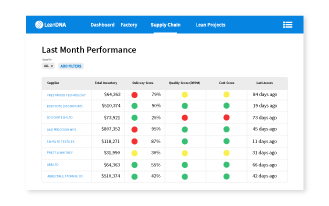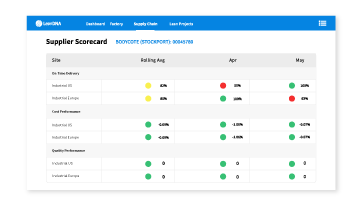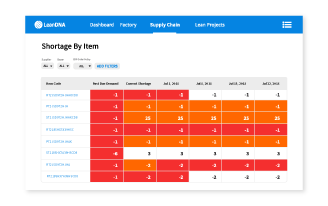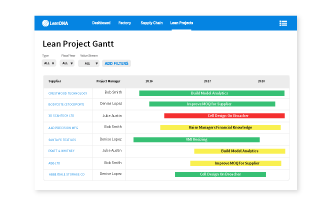As part of a company-wide initiative to reduce working capital and inventory costs, your leadership has just asked you to analyze your supply base and determine the top 10 suppliers requiring improvement. You need an action plan and KPIs to measure performance improvements for those suppliers—and fast. Your supplier development team is struggling to come up with streamlined ways to track supplier performance, understand the root cause of performance issues, and actually drive improvements. Now it's time to scramble as a team to develop and implement an improvement strategy. But where do you start? You need the right supplier performance management tools to achieve these objectives.
At LeanDNA, we’ve run into many companies that are struggling to formulate a streamlined, automated process for improving suppliers. Based on this experience, we’ve compiled a summary of the must-have tools that can help you quickly identify critical suppliers, create an improvement plan, communicate goals with suppliers, and drive improvements.
The tools are organized to support the four basic steps that will help your teams manage and drive effective supplier improvement initiatives:
- Identify and Prioritize
- Communicate
- Collaborate
- Drive Improvement
1. Identify and Prioritize With the Supplier Performance Summary Report
What is the Supplier Performance Summary Report?
This tool will help you answer the questions, “Where do my suppliers rank in terms of Quality, Cost, and Delivery Performance?” and “Which suppliers do I need to prioritize in terms of driving performance improvements?”.
The Supplier Performance Summary report provides the foundation for managing supplier performance. This should be the first supplier performance management tool that your teams create when developing a supplier improvement strategy.
An effective supplier performance summary report should contain basic supplier performance metrics (Quality, Cost, and Delivery Performance) for each supplier. Make sure that you have data from the last quarter, last 6 months, and the last year for comparison purposes. These different time periods allow teams to understand if a supplier is improving or not over time.
It is also helpful to incorporate other information including open order value, total spend, PPV, excess inventory, or shortages along with weekly or monthly changes in those metrics so you can quickly identify if suppliers are actually improving or not. This additional information also allows your teams to sort based on different metrics and drive more tactical weekly efforts. Once your improvement efforts are underway, you’ll want to make sure you see incremental improvements weekly and monthly!
Tactical Usage -- Why is this report important and how will I use it?
Teams will use this report to prioritize their efforts around working with suppliers. When you have a tool containing all suppliers that can be sorted based on critical supplier KPIs, like Quality, Cost, and Delivery, you can focus your efforts on the most critical suppliers and drive the most value quickly.
Supply Chain Leadership, Buyers, and Supplier Development teams can all use this report when reviewing supplier performance, developing sourcing strategies, or determining a supplier improvement plan. It’s important for KPIs to be  standardized and communicated across the entire organization.
standardized and communicated across the entire organization.
Expected Results or Outcomes -- How will this help me achieve my goals?
The best way to improve is to identify the suppliers that need the most improvement. This is a step we often see skipped, but it’s so important!
Providing your supplier development and supply chain management teams with easily accessible and up-to-date supplier performance information ensures that improvement efforts are focused and aligned internally. This report also helps your supply chain teams concentrate on the suppliers that will have the most impact to the business.
2. Communicate With Automated Supplier Scorecards Including Underlying Details
What is the Supplier Scorecard?
A supplier scorecard is a standardized reporting format that is used to provide your team and suppliers with an understanding of whether or not a supplier is hitting their agreed upon goals. A good scorecard clearly and visually answers questions like, “What is a supplier’s Delivery, Quality, or Cost Performance in the prior 30 days, 90 days, or 1 year?”.
Taking it a step further, the ideal scorecard will also contain information about any ongoing improvement initiatives underway at a given supplier, along with the status and owners of those initiatives. The goal is to understand the overall picture of how a supplier is currently performing and what, if anything, is being done to improve that performance.
Tactical Usage -- Why is this report important and how will I use it?
A supplier scorecard helps you track key metrics for suppliers and clearly communicates to the supplier exactly where improvements are needed. It’s also important to have recently updated & easily accessible data to back up any scoring. You should always “speak with data” to ensure meaningful conversations with your suppliers.
In addition to summarizing the metric values for specific time periods in a scorecard format, it is vital to maintain an updated version of the underlying data as well so that any disputes can be quickly resolved.
This underlying data should include:
- Delivery Performance data (e.g. POs and Receipts compared to identify early and late deliveries)
- Spend and Purchase Price Variance (PPV) data
- Quality data (e.g. Defective Parts per Million)
Providing scores is a good start. But if you really want to align with your supplier, it’s important to align on why the supplier was assigned a particular score for any given KPI. Nothing is more frustrating to an improvement team than arguing about the accuracy and validity of arbitrary scores!
Once you’ve established scorecards for your suppliers, you need to start driving regular reviews of these scores with critical suppliers (which you already identified with supplier performance management tool #1). To make these reviews even more effective, you should give suppliers access to their scorecard via a supplier portal. This way, they can review their scores and proactively take improvement actions.

Finally, if you have provided your critical suppliers with a supplier portal, it’s important to enforce the usage of that portal at a regular cadence. You then need some way to track when suppliers are actually accessing their scorecards. If all parties involved (your supplier development teams and your suppliers) are using the same data source and reporting format to manage KPIs and goals, attention can then be turned to the actual improvement activities themselves.
Many companies may already have some form of supplier scorecard, but they are typically built manually and don’t include any built-in communication with the supplier. Automation and supplier communication are critical to driving significant supplier improvement results.
Expected Results or Outcomes -- How will this help me achieve my goals?
Using a well-designed supplier portal that is updated regularly with easily accessible data, your team and the supplier’s team will be empowered to communicate effectively and focus their efforts on improvements that will benefit everyone involved.
3. Collaborate Using the Shortage Management Report with Root Cause Analysis
What exactly is the “Collaborative Shortage Management Report?
This tool will help you address the question, “What shortages are currently impacting me for a certain critical supplier?” and “What is the status on the deliveries from that critical supplier that will resolve my current or projected shortages?”
One common format for this report is a “line of balance,” where shortages are organized and prioritized by shortage date and impact to production. When communicating shortages with a supplier, it’s vital that priorities are communicated correctly so the supplier knows which items and POs they need to focus on first.
The shortage collaboration tool should have a simple mechanism that allows suppliers to understand which deliveries they need to prioritize to alleviate your current or projected shortages. For example, you might include a status field in the report. It should be a text field that is accessible to and editable by both the supplier and buyer, and linked to a specific delivery. This helps direct a supplier’s effort and ensure statuses are kept updated. You will also want to track history on these statuses as well. This is difficult with standard reporting tools, but web-based tools (like LeanDNA) can provide this historical tracking of status.
To take it to yet another level, a truly great collaboration tool allows a user to dig into any shortage and see why the shortage occurred. Was there a PO placed within lead time? Did the supplier miss a delivery? Was an item scrapped on your shop floor? This information provides badly-needed context to any shortage situation and helps you understand which shortages you can avoid next time and which situations may have been out of your or your supplier’s control.
Just like tracking historical status information, this type of analytics (done at the item level) is very difficult to do with traditional static reporting tools. Advanced analytical tools like LeanDNA help provide this much-needed layer on top of traditional shortage reporting methodologies, empowering teams to understand where suppliers can help in resolving shortages vs. where internal processes and teams may need to improve.
Tactical Usage -- Why is this report important and how will I use it?
A collaborative shortage management tool will be used to provide streamlined and seamless communication between all key stakeholders involved in shortage management. That includes your internal buying, planning, management, operations, and production teams in conjunction with your critical suppliers.
Buyers and suppliers will work together using a single, regularly updated source of data (we recommend that data refresh daily) to jointly understand and communicate priorities on deliveries to resolve critical shortages. Status information

will be captured in this report and can be accessed by any stakeholder involved in the shortage management and production process.
Expected Results or Outcomes -- How will this help me achieve my goals?
A single buyer or supplier will no longer be the bottleneck for critical information impacting production. This will save time and reduce the stress on your supply chain teams since information will be much more readily available to those who need it -- supply chain managers, suppliers, and operations. Managers, buyers and suppliers will be empowered to work together more closely and collaboratively without the need for constant phone calls and emails for status updates.
Since suppliers will be more focused on the critical deliveries and have more visibility into changes, overall performance should increase and your on-time delivery will improve as a result.
4. Drive Improvement Using a Supplier Project Management Tool with Supplier Portal
What does a supplier project management tool look like and how would it work?
This tool will help you address the question, “What improvement initiatives are we working on in conjunction with our supplier(s) and who owns those projects, both on our side and on the supplier’s side?”.
An effective supplier improvement project management tool helps you develop and execute targeted supplier improvement initiatives alongside counterparts working at your suppliers. The tool should provide a way for you to track active initiatives containing specific action items, action owers, due dates, and improvement objectives.
The tool should allow project leaders on either your team or your supplier’s team to record and update tasks. Supplier accessibility is very important, so all parties responsible have visibility and accountability for assigned actions.
Finally, it should also link directly to the specific supplier KPIs that your company is tracking in tools #1 and #2. This way, you can ensure that all improvement projects are aligned with the KPIs that you’re trying to drive.
Tactical Usage -- Why is this report important and how will I use it?

A jointly-managed supplier project tracking tool would be used by both your team and the suppliers’ to drive an improvement project review cadence and maintain accountability. Ideally, project reviews would be conducted frequently alongside reviews of supplier KPIs (e.g. Delivery Performance or Quality Performance). Since the supplier performance management tools you created from sections #1 and #2 are also in use and automated, your team gets more time to execute the improvement tasks at hand.
It’s very important to agree on the improvement management framework with the supplier so all efforts are managed as a team with one common goal. After that, when you complete the agreed-upon improvement actions, both businesses see the results!
Expected Results or Outcomes -- How will this help me achieve my goals?
By developing a standard supplier improvement initiative tracking framework that is agreed upon by both your team and the supplier’s team, you will be able to see how your efforts are progressing and how those efforts are contributing to the realization of your supplier improvement goals.
Both your team and the supplier’s team will be empowered with actionable data so you can have a meaningful, productive conversation about where to focus all of your efforts to achieve the best results for your supply chain.
Summary
As you begin your supplier improvement journey, remember that the key is effective and transparent communication. All of the tools described in this post are intended to support that objective so that your relationships with suppliers are improved. Here is a recap of the four basic steps that we started with:
- Identify and Prioritize via a standardized Supplier Performance Summary Report
- Communicate to suppliers through Supplier Scorecards
- Collaborate on Critical Shortages using up-to-date data from your system and status from the supplier
- Drive Improvement using jointly managed Supplier Improvement Initiatives
When deciding how to create these four essential supplier performance management tools, be aware of a few important things.
- To help ensure the validity of the data on an ongoing basis, make sure that these reports are refreshed daily. Otherwise your data becomes stagnant and useless to your team.
- Make sure the information is easily accessible. A web-based tool or globally accessible collaborative platform is the way to go.
- Define standard work procedures for the team to follow with each of the reports. This ensures that all team members are working the same way to achieve the inventory reduction goal.
Whenever you need to quickly build a supplier improvement strategy that works, these four tools are a great place to start. Taken together, they help a supply chain organization understand current performance of their supplier ecosystem and implement a targeted plan to get better.
